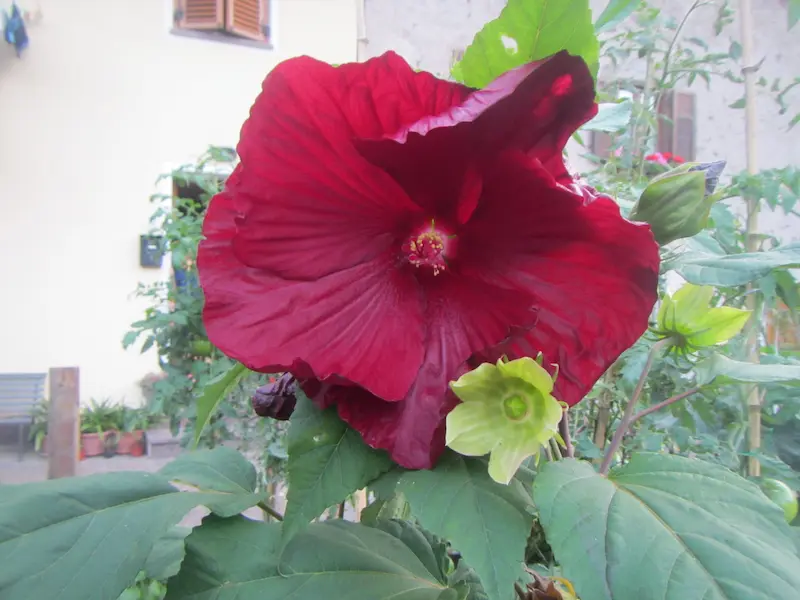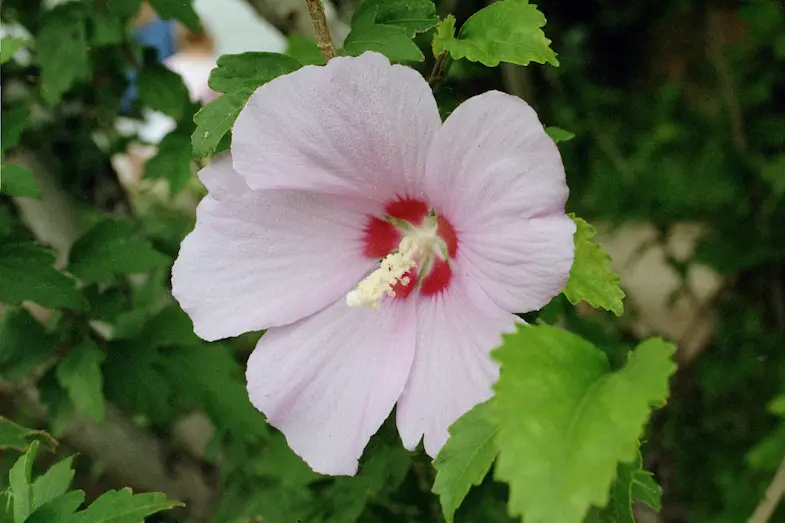Your cart is currently empty!
Red Oak is An Important Tree
The northern red oak is one of the most important trees for timber development in North America. Discover more facts on the Red Oak.
Your cart is currently empty!
Hibiscus ornamentals include varieties that bloom profusely for months, with eye-catching blooms in a variety of colours up to 30 cm wide. Of the flowering plant genus in the mallow family, there are around 400 different varieties of hibiscus including hardy perennials, herbs, vines, annuals, shrubs, or tropical plants. They are grown for a variety of uses, including decorative blossoms, food, and fiber plants.
Originally, hibiscus was only found in the tropics. In recent times, breeders have been developing beautiful “hardy hibiscus” varieties that have been well adapted to northern regions, including Canada. Here are the three primary types:
Botanical Name: Hibiscus moscheutos, Hibiscus syriacus and many more
Genus: Hibiscus
Also Called: Rose of Sharon
En français: Hibiscus
Blooms:
Sun / Shade:
Water: Water daily on the warmest days of summer
Pollinators:
Care:
Hibiscus moscheutos, often known as swamp rose mallow or simply rose mallow, thrives in zones 4–9. It is a cold-hardy wetland plant found in swamps, marshes, and damp areas near rivers and ponds. Even if temperatures dip below freezing in the winter, hardy hibiscus plants will flourish and bloom in your front or backyard garden. From mid-summer through October, they may bloom in pink, white, or purple blooms in a variety of settings. Their blooms may be as little as four inches long and as large as ten inches broad, and the plant as a whole can grow to be two to ten feet tall.

The blossoms of hardy hibiscus are among the largest of any perennial garden shrub. The “Dinner Plate” hibiscus is a cold-hardy shrub with massive, flat circular flowers that can reach 9″ (22 cm) in diameter. They’re popular as decorative plants because of their fragrant blossoms.

Hibiscus syriacus, also considered by some a hardy hibiscus, grows in zones 5-10. This flowering shrub (or small tree) may grow up to eight feet tall and can tolerate below-freezing weather. It has smaller leaves and flowers that bloom at around two to four inches across. The optimal conditions for this perennial hibiscus are a mix of full sun and moderate shade, as well as acidic, well-draining soil.

Hibiscus rosa-sinensis is a tropical hibiscus for zones 8-11. Their cultivars can withstand high temperatures and are commonly planted outside in subtropical and tropical climates. Outside of their native location, they are frequently cultivated as annuals. If you don’t live in one of these zones, you may grow them in pots and bring them inside during the winter. If the temperature is hot and dry, the tropical hibiscus blooms between summer and fall. In hot weather, this hibiscus may become quite thirsty, demanding frequent watering. This hibiscus can grow up to 15 feet tall and has blooms that range in size from three to ten inches in diameter.
Hibiscus can also be grown indoors as annuals or perennials and are often grown as houseplants. They are able to thrive in a container; plant in a big container. They have to be kept in a bright spot near a sunny window, but not in direct sunlight.
Hibiscus grows best in full light. However, in southern zones, owing to the intensity of sunshine and heat, filtered sunlight may be preferable.
Water your hibiscus deeply every week during its growing season. It can be thirsty plants when growing. A drought is not their friend. Add mulch and/or compost on top.
Hibiscus can grow in a wide range of soil conditions, but it prefers soils that contain organic matter and are slightly acidic and loamy. Hibiscus moscheutos and many of their herbaceous, hardy perennial cousins are swamp natives, so they require plenty of moisture. Soil acidity can affect colour: the more acidic, the deeper the pink, while grey or green indicates a base.
Hibiscus don’t like to be submerged in soil, and they like moist soil. So, spring and summer, mulch them to keep the soil from getting too dry.
Mulching the base of shrubs in late fall will increase overwinter survival; straw can also be used. Hardy Hibiscus dies back to the ground for winter. It will reappear in late spring or early summer, in part depending on how hard the winter was. Mark its placement so that you don’t accidentally dig it up in the spring.
Prune an established hibiscus to keep growth in check; winter pruning is highly recommended. You can prune aggressively. Pruning selected branches permits you to shape the plant. Pruning spent flowers will encourage blooming. Remove yellow leaves and damaged or diseased branches. Pinching growing tips leads to a fuller bush. Click here for the full article on pruning hibiscus.
Hibiscus loves extra nitrogen, so fertilize them moderately during their growing season with an all-purpose, slow release fertilizer. Dilute feeding every two weeks. If desired, acidify the soil to influence flower colour.
Meal bugs, spider mites, aphids, and whiteflies are common pests of hibiscus plants. If you experience problems with pests, try growing your hibiscus in a container. Or, have a plan to remove pests. Here’s a great article on removing aphids.

It is more difficult to grow hibiscus from seeds than from cuttings or division. Note that Hibiscus rosa-sinensis, for example, often does not produce seeds.
Seeds might take a long time to germinate and require a lot of care.
Seedlings appear between two and four weeks after planting. They will need gradual hardening off before transplanting.

Stem cutting is the simplest technique to propagate hibiscus.
Mature hibiscus does not tolerate transplanting well. A thorough preparation is essential for effectively transplanting a hibiscus. The best time to transplant a hardy hibiscus is in early fall, after the perennial has completed flowering.
Hibiscus tea is made from dried petals. To dry petals, the hibiscus flowers need to be free of pesticides and dried in the sun on a drying rack. A quicker method, if you are in a rush, is to drop them into a food dehydrator. Once dried, they can be used for teas, potpourri, dried flower art and wreathes.
Tea is easy to make from dried petals. There are many recipes, here is one for your consideration Here is one recipe.
Hibiscus flowers are edible, but the seeds are not. The edible parts of the plant are the leaves, flowers, and petals. The flowers have a strong, minty scent that is often used in perfumes and foods. The dried petals are often used in confections and tea.
Hibiscus flowers, buds, leaves, and stems are all eaten by deer. They are a favourite of deer since they are well-watered, fertilized, and edible to them.
The British have named ships after plants more than any other nation. Two British Royal Navy vessels were named HMS Hibiscus: HMS Hibiscus (1917), a sloop used until 1923, and HMS Hibiscus (K24), a corvette launched in 1940 and retired in 1946. Several non-naval British ships have also been named “Rose of Sharon.”
Source: Top Canadian Ornamental Plants: Hibiscus Page 45
Hibiscus are beautiful tropical flowers that are often grown as annuals or as houseplants. They can be grown in a wide range of climates and are often used to improve mental health and mood, treat anxiety, and improve memory. Hibiscus flowers can also be eaten and are often used in cosmetics and fragrances. The hibiscus is a great plant for a sunny window. They are easy to grow and require very little maintenance. When you grow hibiscus, you will enjoy the beautiful flowers and impressive perennial growth
The northern red oak is one of the most important trees for timber development in North America. Discover more facts on the Red Oak.
Maiden grass is a popular, rich, tall, full-bodied herbaceous perennial and hardy ornamental grass. Learn how to use and care in your home.
Softened water can be severely damaging to plants. Using softened water should be done in a controlled manner, and avoided whenever possible.
Learn how to attract woodpeckers to your garden with native plants that provide food and habitat, based on expert advice.
Discover the best time to harvest garlic, from shoots to scapes, and learn how to maximize bulb size and flavor. Find expert tips from Master Gardener Dale Odorizzi.
Get rid of Burdock & Wild Parsnip in your garden before it's too late! Control these noxious weeds now and enjoy a more manageable garden.
GardeningCalendar.ca gets some funding from advertisers. If you click on links and advertisements at no cost to you, the site may receive a small commission that helps fund its operation.
© 2025 J&S Calendars Ltd.
Leave a Reply
You must be logged in to post a comment.